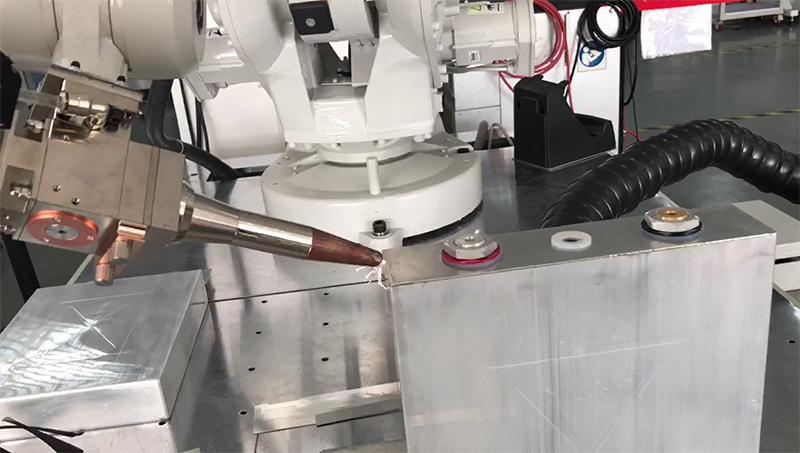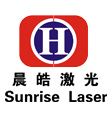Application of laser welding machine on power battery

Power battery refers to the green energy battery used in electric vehicles. Compared with small-capacity batteries (such as mobile phones, laptop batteries, etc.), it has large capacity and output power, and can be used for electric vehicle driving power and large mobile power. Secondary batteries for application fields. Lithium-ion battery or battery packs are manufactured in many processes, including multiple processes such as explosion-proof valve seal welding, tab welding, soft joint soldering, hard hat spot welding, battery case sealing soldering, module and PACK soldering. All are welded by laser welding machine as the best process. The materials used for welding the power battery are mainly pure copper, aluminum and aluminum alloy, stainless steel and so on.
1, battery explosion-proof valve welding
The explosion-proof valve of the battery is a thin-walled valve body on the battery sealing plate. When the internal pressure of the battery exceeds the specified value, the explosion-proof valve body is broken to prevent the battery from bursting. The safety valve is ingeniously constructed, and this process is extremely strict with the laser welding process. Prior to continuous laser welding, the explosion-proof valve of the battery was welded by pulsed laser. The continuous sealing welding was achieved by the overlap and coverage of the solder joints and the solder joints, but the welding efficiency was low and the sealing performance was relatively poor. Continuous laser welding enables high-speed, high-quality welding, and weld stability, welding efficiency, and yield are guaranteed.
2, battery ear soldering
The tabs are usually divided into three materials, the anode of the battery is made of aluminum ( Al) material, and the negative electrode is made of nickel (Ni) material or copper-plated nickel (Ni-Cu) material. In the manufacturing process of the power battery, one of the links is to solder the battery tabs to the poles. In the manufacture of the secondary battery, it is necessary to weld it together with another safety valve made of aluminum. Welding not only ensures a reliable connection between the poles and the poles, but also requires a smooth and beautiful weld.
3, the battery is spot welded
Materials used in battery poles include pure aluminum tape, nickel tape, aluminum-nickel composite tape, and a small amount of copper tape. The welding of the battery poles generally uses a pulse welding machine. With the advent of IPG QCW quasi-continuous lasers, it has also been widely used in battery strip welding, and because of its good beam quality, the welding spot can be made very small. It has unique advantages in welding high-reflectivity aluminum strips, copper strips, and narrow-band battery strips (with strip widths below 1.5 mm).
4, power battery housing and cover seal welding
The housing material of the power battery is aluminum alloy and stainless steel, among which aluminum alloy is the most common, generally 3003 aluminum alloy, and a few use pure aluminum. Stainless steel is the best laser welding material, especially 304 stainless steel, which can obtain welds with good appearance and performance whether it is pulse or continuous laser.
The laser welding performance of aluminum and aluminum alloys varies slightly depending on the welding method used. Except for pure aluminum and 3 series aluminum alloy, there is no problem in pulse welding and continuous welding. The other series of aluminum alloys are optimally selected for continuous laser welding to reduce crack sensitivity. At the same time, according to the thickness of the power battery casing, a laser with a suitable power is selected. When the thickness of the casing is less than 1 mm, a single-mode laser of 1000 W or less can be considered, and a single-mode or multi-mode laser of 1000 W or more is required for a thickness of 1 mm or more.
Small- capacity lithium batteries often use a relatively thin aluminum shell (having a thickness of about 0.25 mm), and a steel shell such as 18650. Due to the thickness of the casing, the welding of such batteries generally uses a lower power laser. Using a continuous laser to solder a thin-shell lithium battery, the efficiency can be increased by 5 to 10 times, and the appearance and sealing are better. Therefore there is a trend to gradually replace pulsed lasers in this field of application.
5, power battery module and pack welding
The series-parallel connection between the power batteries is generally completed by the welding of the connecting piece and the single cell. The material of the positive and negative electrodes is different, generally there are two kinds of materials, copper and aluminum. Because of the brittle compound formed by laser welding between copper and aluminum, it is impossible to form a brittle compound. In order to meet the requirements of use, usually by ultrasonic welding, copper and copper, aluminum and aluminum are generally laser welded. At the same time, since copper and aluminum transfer heat very quickly, and the laser reflectance is very high, the thickness of the connecting piece is relatively large, so it is necessary to use a higher power laser to achieve welding.
(This article was originally written by Sunrise Laser. The reprint must indicate the source: www.lasersunrise.com , cherish the labor results of others, is to respect yourself)










